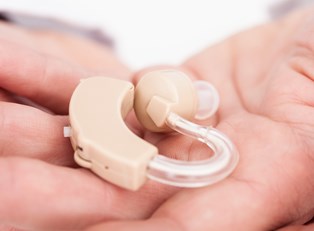A hearing aid is one of the many medical devices designed to help those with physical disabilities, hearing conditions in this case, lead normal and productive lives. All hearing aids have the same purpose, but models differ in terms of their sizes, shapes and how they function. If you have an auditory condition, you will need to understand these differences before you consider purchasing a hearing aid.
Identifying and Correcting Auditory Conditions
Auditory conditions have many underlying causes, including infections and even something as simple as wax blocking the ear canal. Problems may result from defects in the ear itself or from prolonged exposure to loud noise. Surgery may be helpful for some individuals, but those with permanent damage will almost certainly require a hearing aid. Most units available today use digital technology, employing a computer chip to amplify or augment sounds heard by the wearer.
Types of Hearing Aids
People who are sensitive about the appearance of a hearing aid will often choose units that are smaller and less visible. In this regard, some aids fit completely or partially inside a person's ear, making them almost invisible to the outside and less vulnerable to interference in windy conditions. However, these aids usually lack the features found on larger units, including volume control, and their smaller batteries have limited operating spans.
Shell-type units sit in the "bowl" section of the outer ear, although they may have to be custom made to fit the user. Though obviously visible from the outside, these hearing aids are actually easier to use than smaller units and offer such features as volume control and directional microphones. These units can make it possible to more clearly hear sounds in front of the wearer, such as the voice of someone else, while reducing ambient noise emanating from the sides or rear. They also use larger batteries that will last longer. However, units worn outside the air can be affected by the wind.
Units that fit behind the ear can be beneficial to those of almost any age and who suffer from almost any type of hearing loss, although the size of these units makes the hearing problem obvious to others.
Choosing a Hearing Aid
It is important to understand the condition of your ears before you even consider wearing a hearing aid. This will require an examination by a health professional to determine whether you actually need one. If you do, you should ask for a trial period to determine what type best fits your needs. Because any hearing aid may malfunction during its time of use, you should select a unit that comes with a good warranty.
You also need to consider the possibility that your hearing may worsen over time, requiring an aid that can be adjusted to these changes. Finally, you should understand that any hearing aid will not restore your hearing to perfection. Properly fit and worn, however, a hearing aid can make your life a lot easier.



